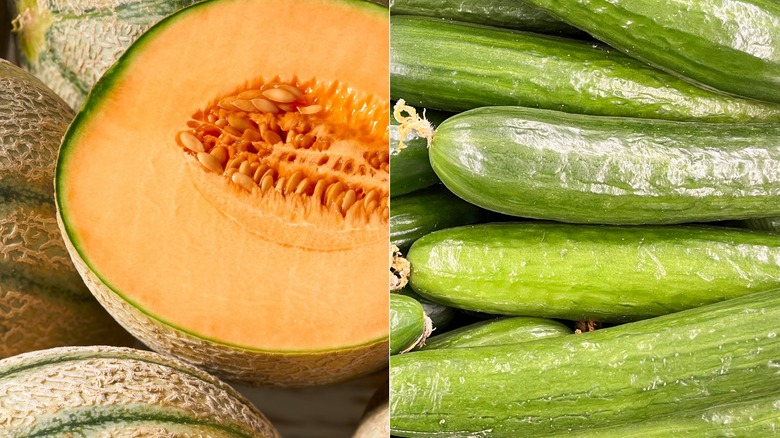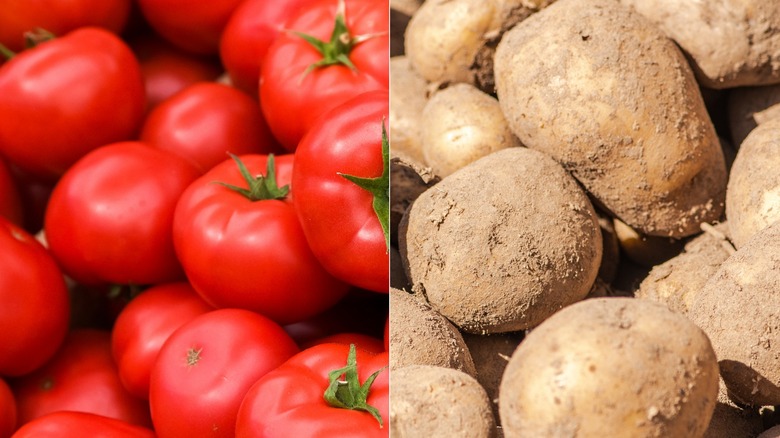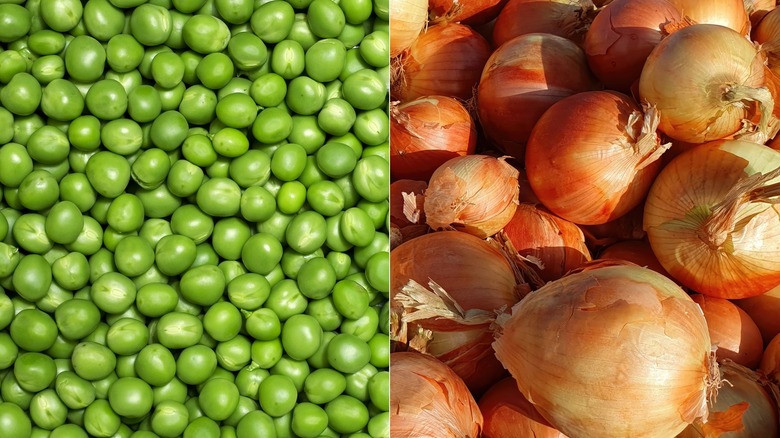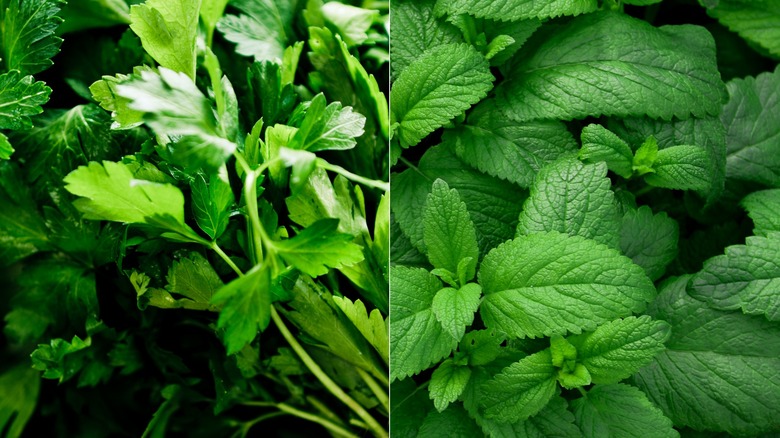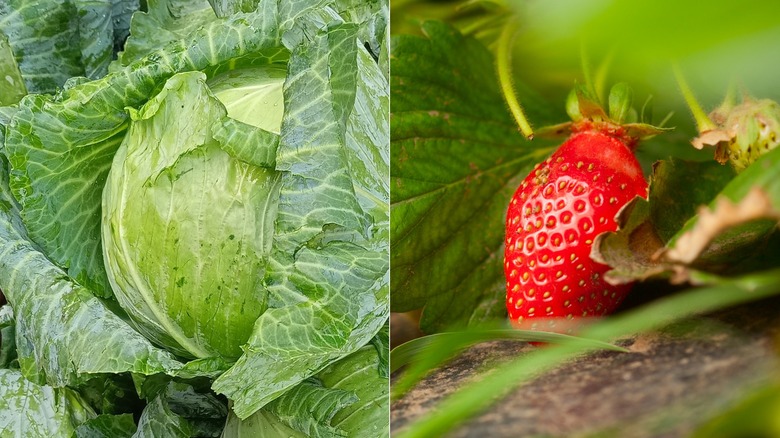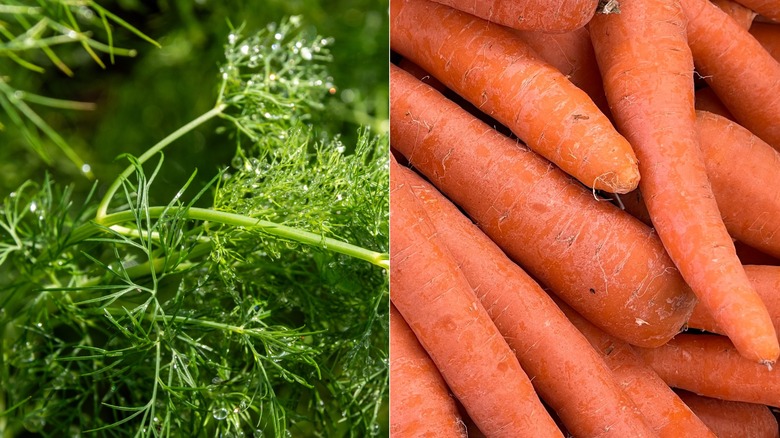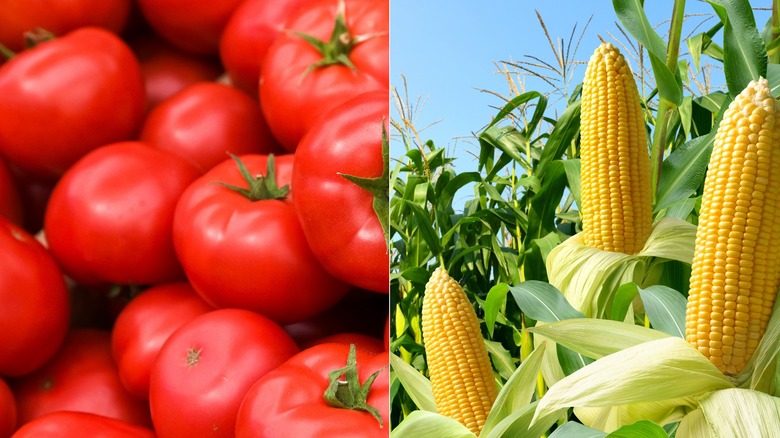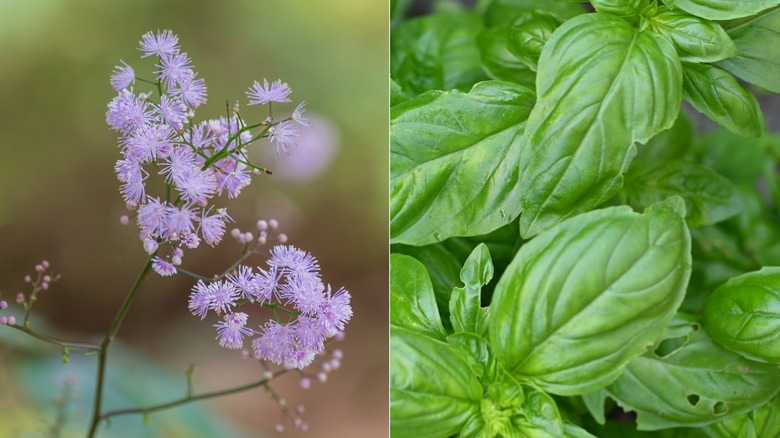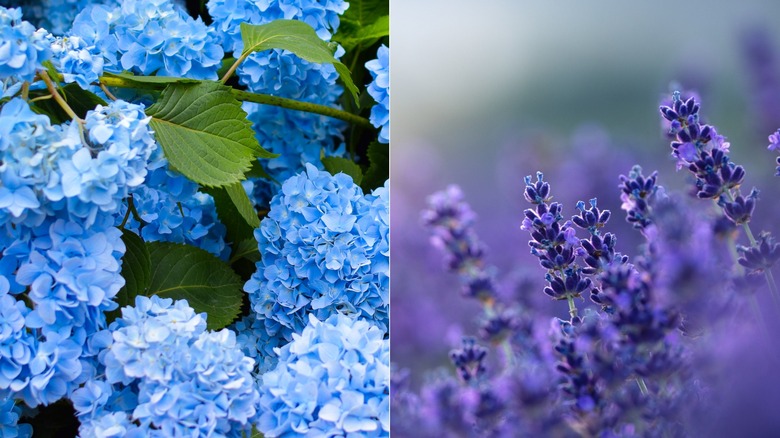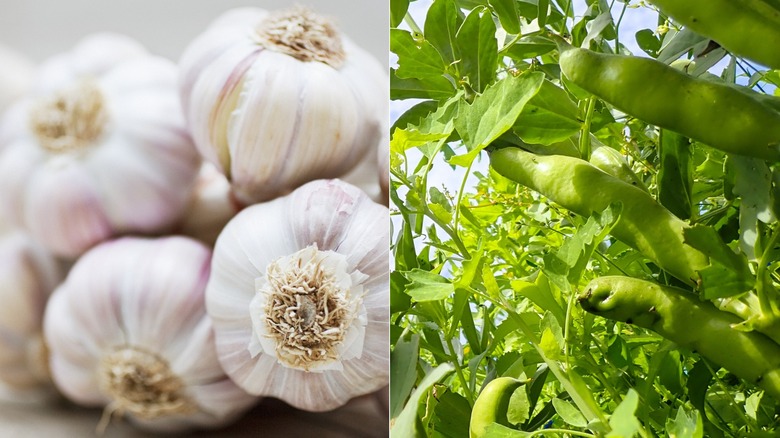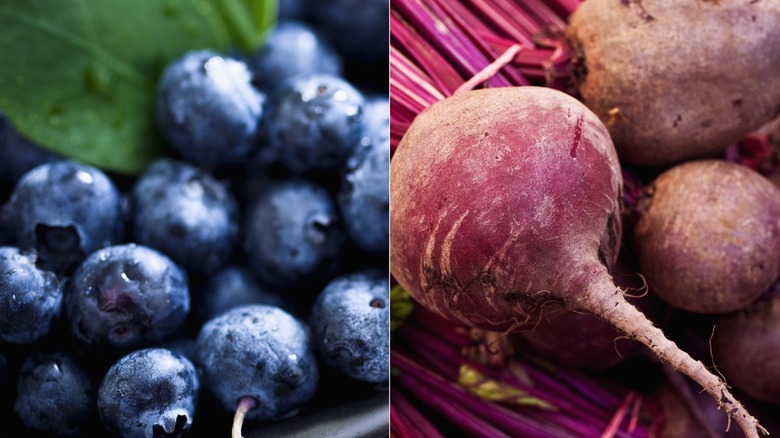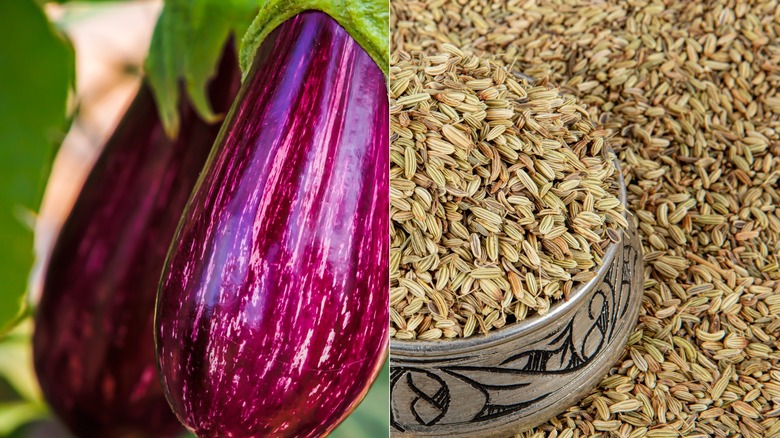Never Grow These Plants Together In Your Garden
When it comes to gardening, the intricate relationships between different plant species can significantly influence the health and vitality of a garden. Companion planting, a nuanced and intentional approach, involves strategically placing specific plants near each other to maximize their mutual benefits or address potential conflicts. This delicate dance of compatibility and cooperation is a key factor in creating thriving ecosystems within your garden.
Companion planting extends beyond merely arranging plants for aesthetic appeal; it's a strategic effort to enhance overall garden health. Some plants act as excellent companions, contributing to the well-being of their neighbors by fostering growth, deterring pests, or enhancing soil conditions. However, the converse is also true —certain plants may engage in subtle conflicts that hinder the growth and development of neighboring species.
Today, we're delving into the workings of specific plant duos, unraveling the potential pitfalls and challenges that arise when incompatible plants share the same space. Whether you're a seasoned gardener or a novice enthusiast, knowing these incompatible combinations will help you cultivate a sustainable and resilient landscape.
Cucumbers and melons
While the idea of pairing cucumbers and melons in your garden may initially seem like a natural and visually appealing choice, the reality is that this seemingly harmonious match can evolve into a complex gardening challenge. The shared vine-like structures and preference for warm climates of both cucumbers and melons create an environment ripe for potential issues. Melons, including watermelons and cantaloupes, exhibit a propensity for attracting pests that can prove detrimental to cucumber plants (via The Spruce).
Firstly, the pests drawn to melons have the potential to not only spread diseases but also actively stunt the growth of cucumber plants, according to Gardenia. Secondly, both cucumbers and melons share the characteristic of being heavy feeders, instigating a competition for the same essential nutrients present in the soil. This intense rivalry for nutrients can result in reduced nutrient availability for both crops, leading to suboptimal growth and potentially diminishing the overall yield of cucumbers and melons alike.
To mitigate these issues, plant cucumbers and melons in separate areas of the garden. This will minimize the risk of pests and diseases spreading between them. Additionally, providing ample spacing between rows and individual plants further reduces the competition for nutrients and sunlight, allowing each crop to thrive independently.
Tomatoes and potatoes
The allure of planting tomatoes and potatoes in close proximity stems from their shared botanical lineage within the nightshade family (Solanaceae) and their analogous growth habits. This belief, coupled with the desire for efficient space utilization — particularly relevant in smaller garden plots — encourages many gardeners to consider this seemingly harmonious combination.
However, beneath the surface of this ostensibly advantageous pairing lie potential challenges that may impact the overall success of both crops. One significant concern is the susceptibility of tomatoes and potatoes to shared pests and diseases. In particular, these two vegetables have a specific propensity for late blight (via Government of Saskatchewan). By cohabitating, these crops create an environment conducive to the simultaneous outbreak of these issues, amplifying the risk and posing a potential threat to the health and vigor of both tomato and potato plants.
To address the potential challenges, consider implementing a companion planting strategy with intervening crops to mitigate shared risks and promote a more harmonious garden environment. One effective alternative is to intersperse these nightshade family members with plants that act as natural repellents for common pests and diseases affecting tomatoes and potatoes.
Peas and onions
The decision to plant onions and peas together, often driven by the aspiration for a diverse and compact garden, unveils challenges that can influence their mutual success. Gardeners seeking to maximize space by interplanting different crops might find the distinct growth habits of onions and peas seemingly complementary.
However, pitfalls emerge from this pairing. Onions release substances into the soil that inhibit the growth of peas, an attribute beneficial for onions but detrimental to peas. This chemical inhibition can stunt the development of pea plants, impacting their overall productivity, according to Gardenia. Moreover, onions and peas exhibit differing soil and water requirements (via Home and Gardens). Onions thrive in well-drained soil with moderate moisture, while peas prefer soil with higher moisture levels. This variance in preferences may lead to suboptimal growing conditions for one or both crops.
A strategic solution to navigate these challenges involves planting onions and peas in raised beds or individual containers filled with a customized soil mix. This approach minimizes the impact of substances released by onions on the surrounding soil, providing a more controlled environment for both crops. By adopting these adjustments, gardeners can strike a balance between their desire for a diverse and compact garden and the nuanced requirements of onions and peas, fostering optimal conditions for the success of each crop.
Mint and parsley
The motivation behind planting mint and parsley together often stems from the desire to enjoy their complementary flavors in various culinary dishes. The idea of having these herbs side by side not only facilitates easy access but also contributes to the aesthetic appeal of an herb garden, where different herbs harmoniously coexist. While the prospect of cultivating the aromatic duo of mint and parsley might initially seem enticing, it's essential to delve into the potential challenges associated with co-planting these herbs in the same garden bed.
Mint, characterized by its vigorous growth and rapid spreading, can quickly become overwhelming, overshadowing, and outcompeting the more delicate parsley (via Master Class). The aggressive nature of mint leads to reduced sunlight and nutrient availability for parsley, hampering its growth potential. In extreme cases, the robust growth of mint may even result in the loss of parsley as it struggles to compete for essential resources.
To address these challenges, physical barriers like edging or containers buried in the soil can be employed to contain mint's spreading roots, ensuring that it doesn't encroach upon the growing space designated for parsley. Additionally, regular pruning and harvesting of mint become essential practices to keep its growth in check. Consistently cutting back mint prevents it from dominating the shared space and provides parsley, as well as any other neighboring plants, with a more favorable environment to thrive.
Cabbages and strawberries
Cultivating a diverse garden is beneficial for overall ecosystem health. This is one of the reasons that gardeners frequently gravitate towards interplanting different crops to maximize garden space. The pairing of cabbages and strawberries may be inspired by this space-utilization strategy. However, the potential pitfalls of combining cabbages and strawberries are significant. Both crops share similar nutrient preferences. Planting them in close proximity may instigate fierce competition for these essential nutrients in the soil, according to Homes and Gardens. This competition, in turn, can lead to compromised growth for both cabbages and strawberries, resulting in stunted plants and smaller fruits.
Beyond nutrient competition, the consequences extend to an increased susceptibility to diseases. Weakened plants, a byproduct of nutrient rivalry, become more vulnerable to infections. This heightened susceptibility affects the overall health of both cabbages and strawberries, potentially compromising their vitality.
If you do want your garden to house both strawberries and cabbages, try implementing a successive planting schedule. This entails growing cabbages and strawberries in the same space but at different times, allowing each crop to access nutrients without simultaneous competition. By staggering the planting, gardeners can optimize nutrient availability for each crop, mitigating the risks associated with nutrient competition and fostering a more harmonious coexistence in the garden.
Dill and carrots
The enticing and earthy combination of carrots and dill may inspire gardeners to co-plant these crops, but the endeavor requires careful consideration of potential challenges, particularly their shared susceptibility to certain pests.
Dill, while aromatic and flavorful, has a tendency to attract pests, notably aphids and spider mites, which can be detrimental to carrots (via Gardenia). These pests are drawn to the tender foliage of dill and can swiftly spread to neighboring carrot plants, posing a threat to their health and productivity. The consequences may manifest as a reduced carrot yield, as the pests consume or damage the plants, impacting overall productivity. Additionally, carrots may suffer from physical damage caused by pest feeding, resulting in deformed or stunted roots that compromise their quality.
To avoid these pitfalls, spatially separate your carrots from your dill. Minimizing direct contact by planting them in different rows or in entirely different parts of your garden will reduce the potential spread of pests between the two crops. Providing sufficient distance between the crops acts as a deterrent, making it less convenient for pests to move easily from dill to carrots. This spatial strategy aims to mitigate the risks associated with pest interactions, allowing both crops to flourish independently, whilst allowing you to still indulge in the culinary benefits of both foods.
Tomatoes and corn
The picturesque combination of tall, majestic corn stalks intertwined with the vibrant foliage of tomatoes may be visually appealing, yet it's imperative to recognize the challenges that arise from the shared demands of these crops.
As considered heavy feeders, these crops demand substantial amounts of essential nutrients. Master Class warns that planting them together exacerbates the competition for these elements in the soil, creating an environment where both crops vie for limited resources. Adding complexity to the challenge is the shared susceptibility of corn and tomatoes to the same pests, such as aphids and corn earworms, along with similar bacterial and fungal diseases (via The Spruce).
The combined impact of nutrient competition and shared pests manifests in reduced yields for both corn and tomatoes. Plants may exhibit stunted growth, yield smaller fruits, and experience an overall decline in productivity. To address these challenges, a strategic approach involves practicing crop rotation. Avoid planting corn and tomatoes in the same location in consecutive years to break the cycle of shared pests and diseases. This thoughtful rotation not only preserves the visual allure of the corn and tomato combination but also promotes the long-term health and productivity of both crops.
Rue and basil
The occasional culinary pairing of rue and basil in various dishes may inspire gardeners to cultivate these herbs for convenient access to both in the kitchen. However, this shortcut may cause more inconvenience in the long term.
Rue produces allelopathic substances, according to a study by Agriallis. Allelopathy involves the release of chemical compounds that inhibit the growth of other plants in close proximity. According to Living Seeds, these effects of rue can result in smaller basil plants, potentially compromising the overall quality of the herb. In severe cases, the allelopathic effects of rue might even lead to the loss of basil plants as they struggle to thrive in the presence of inhibitory compounds.
To avoid these issues, plant basil and rue far away from each other to avoid chemical interactions. Also of note, certain basil cultivars exhibit greater tolerance to the inhibitory effects of rue, allowing for a more harmonious coexistence. By making informed choices about basil varieties, gardeners can preserve the aromatic combination of rue and basil while minimizing the potential negative impacts of allelopathic interactions.
Hydrangeas and lavender
The allure of combining the aromatic charm of lavender with the vibrant blooms of hydrangeas may inspire gardeners, but it's essential to carefully consider the divergent soil preferences of these plants to ensure their harmonious coexistence.
Blooming Backyard states that lavenders thrive in well-drained, dry soil, while hydrangeas prefer consistently moist or even damp conditions. Planting them together in the same soil may create suboptimal conditions for one or both plants. The consequences may manifest as suboptimal growth for both lavender and hydrangeas. Lavenders struggling in overly moist soil may experience poor growth and potential root rot. On the other hand, hydrangeas in excessively dry soil may exhibit stunted growth, reduced flowering, and increased susceptibility to stress-related issues.
An easy fix to this solution is to plant lavender and hydrangeas in separate areas or beds to accommodate their distinct soil preferences. Providing sufficient distance between the two plants ensures that each can thrive in conditions tailored to their specific needs.
Garlic and beans
Some gardeners may be inclined to plant garlic and beans together based on companion planting traditions, hoping for mutual benefits in terms of growth enhancement or pest protection.
However, the potential pitfalls and repercussions of this pairing revolve around the allelopathic compounds produced by garlic, such as sulfur. These compounds have the capacity to inhibit the growth of neighboring plants, including beans. The inhibitory effects may impede germination and stunt the growth of bean plants, compromising their overall development. The consequences of garlic's allelopathic compounds extend to both garlic and beans, resulting in reduced growth for both crops. As Lauren Ritz found out and shared on Permies, when both are grown together, garlic may not achieve its full potential, and bean plants may struggle to develop, leading to a less-than-optimal yield.
To contain the allelopathic compounds to a specific area and reduce their impact on neighboring bean plants, try to plant these crops in raised beds. Alternatively, keep garlic grown in its own individual container.
Blueberries and beets
The vibrant hues of blueberries and the earthy appeal of beets might seem like a charming combination, but their distinct soil preferences necessitate careful consideration to ensure both crops thrive.
Blueberries prefer acidic soil, while beets thrive in slightly more alkaline conditions, according to Rural Sprout. Planting them together in the same soil may result in suboptimal conditions for one or both crops. The consequences of this soil mismatch may manifest as suboptimal growth for both blueberries and beets. Blueberries may suffer in alkaline soil, leading to poor growth, nutrient deficiencies, and reduced fruiting. Similarly, beets may encounter challenges in acidic soil, affecting their root development and overall productivity.
To address these challenges, plant blueberries and beets in separate soil beds where the pH is optimal for their specific conditions. Furthermore, maintaining a clear distinction in soil beds allows for targeted soil amendments and adjustments tailored to the unique nutritional needs of blueberries and beets.
Eggplant and fennel
While the feathery fronds of fennel and the glossy fruits of eggplant may seem like a delightful combination, it's imperative to be cognizant of potential interactions that can significantly impact the growth and productivity of both plants.
One critical consideration is the fact that fennel has a tendency to attract a myriad of pests that can be particularly detrimental to the well-being of eggplants. In fact, according to West Coast Seeds, fennel is not only a magnet for pests but can also exert negative effects on the growth of many vegetables. They advise that fennel should be kept out of vegetable gardens altogether.
Recognizing the desire some gardeners may have to include fennel in their garden despite its potential drawbacks, a practical and effective solution is to allocate a dedicated space or container exclusively for fennel. By maintaining a mindful and strategic approach to the placement of fennel, gardeners can still enjoy the aesthetic appeal of this herb while safeguarding the growth and productivity of their other vegetable plants, such as eggplants, from potential adverse effects.

